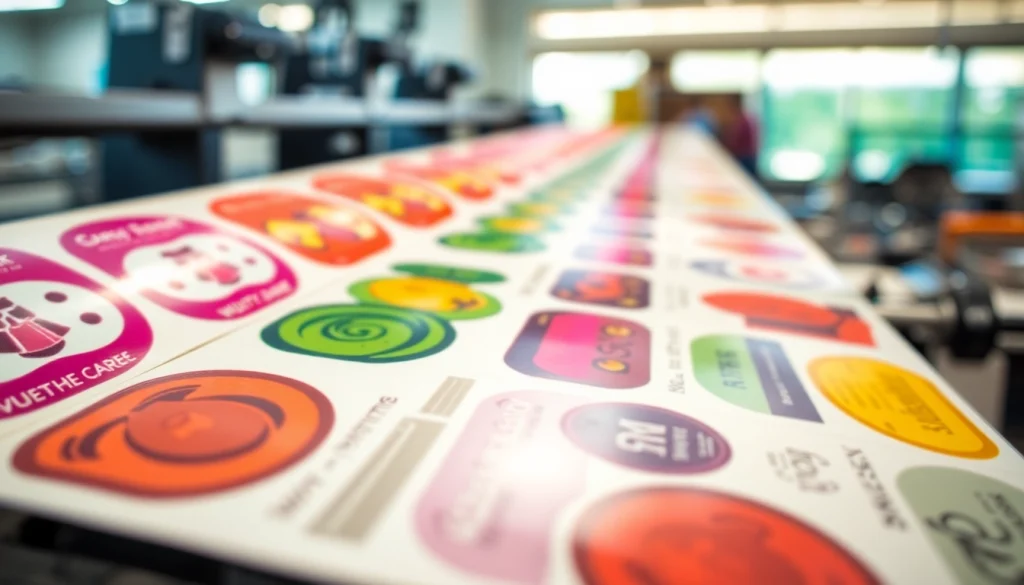In today’s competitive market, the importance of effective labels and printing cannot be overstated. Labels serve as a vital component of a brand’s identity and play significant roles in marketing, compliance, and product recognition. Whether you are a business owner, a designer, or just someone interested in enhancing your products, understanding the nuances of labels and printing will empower you to make informed decisions that can elevate your brand visibility and efficiency. From the materials used in labels to the printing processes and design strategies, this comprehensive guide will explore every aspect necessary for achieving successful label printing.
Understanding the Basics of Labels and Printing
What Are Labels in Printing?
Labels are versatile printed materials applied to various surfaces for identification, promotion, and information. They can take many forms, including adhesive labels found on bottles, packaging labels on shipping cartons, and tags attached to clothing. Labels enhance the consumer experience by providing essential details such as ingredients, care instructions, and branding elements. Their primary function is to deliver information concisely and attractively, leveraging visual elements to influence buyer decisions.
In the context of printing, labels can be categorized into several types: pressure-sensitive labels, shrink sleeves, and in-mold labels. Each type has distinctive characteristics and applications suited to different requirements.
Key Materials Used for Labels
The choice of material plays a crucial role in label performance, aesthetics, and durability. Common materials include:
- Paper: A widely used option for indoor applications, paper labels are economical and can be printed with vibrant colors.
- Vinyl: This material offers water and tear resistance, making it ideal for outdoor products.
- Polyester: Known for its durability, polyester labels withstand harsh conditions, such as extreme temperatures and chemicals.
- Biodegradable materials: With rising environmental consciousness, materials like biodegradable paper or plant-based plastics gain popularity for eco-friendly labeling.
Understanding the right material for your specific needs contributes significantly to the effectiveness of the labels in their intended environment.
The Printing Process Explained
The printing process for labels involves several steps to ensure high quality and efficiency. Here’s a brief overview:
- Design: This is the creative phase where graphic designers collaborate with clients to create a visually appealing layout that aligns with branding guidelines.
- Prepress: In this stage, the design is prepared for printing, involving color management, proofing, and final adjustments to ensure accuracy.
- Printing: Various printing techniques can be employed, including digital printing, flexography, and offset printing. The choice of method depends on volume, budget, and quality requirements.
- Finishing: After printing, labels may undergo finishing processes like die-cutting, laminating, or applying special effects to enhance appearance and durability.
- Quality Control: The final stage ensures that the labels meet specified standards before they are distributed.
By understanding the printing process, businesses can better control costs, timelines, and the overall quality of their labels.
Choosing the Right Labels for Your Needs
Types of Labels and Their Applications
Labels come in various forms, each serving distinct purposes across industries:
- Shipping labels: Used for identifying packages, shipping labels include barcodes and tracking information.
- Product labels: Found on consumer goods, product labels provide essential information, branding, and marketing.
- Barcode labels: Essential for inventory management, barcode labels allow for quick scanning and tracking of products.
- Promotional labels: Used to attract attention, promotional labels are often employed for discounts or special events.
Understanding the functionality and application of different label types can help businesses make an informed choice that caters to their specific needs.
Factors to Consider When Selecting Labels
Choosing the right labels requires careful consideration of several factors:
- Purpose: Define the label’s function clearly—whether it is for identification, branding, or regulatory compliance.
- Material: Select a material that suits the environment in which the label will be used, considering factors such as moisture exposure and temperature extremes.
- Design: The design must be appropriate for the target audience, enhancing user engagement without jeopardizing essential information.
- Print technology: Different printing technologies have implications for cost, time, and quality—understanding these will help in selecting the right printing partner.
Taking the time to evaluate these factors ensures you select labels that will meet your requirements effectively and aesthetically.
Custom vs. Pre-Printed Labels
When it comes to acquiring labels, businesses often face the decision between custom and pre-printed options. Each has its benefits:
- Custom labels: Perfect for brands seeking a unique look or specific functionality. They can be tailored to fit any size, shape, or design need, but tend to have longer lead times and higher upfront costs.
- Pre-printed labels: Cost-effective and readily available, pre-printed labels work well for high-volume needs where uniformity is crucial, though they may lack flexibility in design variations.
Understanding the pros and cons of each option allows businesses to evaluate which labels are best for their specific project timelines and budgets.
Designing Effective Labels
Essential Elements of Label Design
Design plays a pivotal role in the effectiveness of labels. Key elements to consider include:
- Branding: Consistent use of logos, colors, and fonts strengthens brand identity and aids recognition.
- Information Hierarchy: Organizing information with clear headings and logical flow ensures important details are easily accessible.
- Call to Action: Including clear prompts on promotional labels can enhance customer engagement and drive actions.
- Visual Appeal: Effective use of images, colors, and fonts can draw attention and create a lasting impression.
Incorporating these elements will lead to labels that not only look great but also perform their intended functions effectively.
Color Psychology and Label Impact
Color selection significantly impacts how labels are perceived. Different colors evoke distinct emotions and associations, which can affect consumer behavior:
- Red: Associated with urgency and excitement, often used in clearance sales.
- Blue: Conveys trust and reliability, making it a popular choice for corporate branding.
- Green: Represents nature and health, frequently used in organic product labels.
- Yellow: Associated with happiness and positivity, often integrated into promotional labels to create an inviting feel.
Understanding these associations allows brands to select color palettes that resonate with their target audience and enhance their message.
Typography Tips for Labels
Typography influences the readability and aesthetics of labels. Here are some essential tips:
- Font Selection: Choose fonts that reflect your brand while also being clear and legible.
- Size Matters: Ensure that critical information is large enough to be easily read, even from a distance.
- Limit Font Number: Use no more than two to three font types to maintain a cohesive look and prevent visual clutter.
- Test Readability: Always conduct tests to evaluate how well your audience can read and understand the text on your labels.
Attention to typography can significantly enhance the effectiveness of your label design and ensure that core messages are communicated successfully.
Optimizing Your Printing Process
Choosing the Right Printing Technology
Selecting the appropriate printing technology is crucial for producing high-quality labels efficiently. The common methods include:
- Digital Printing: Ideal for short runs and customization, offering quick turnaround times and flexibility in design.
- Flexographic Printing: Best for large volumes, especially with continuous patterns, flexography offers high speed and efficiency.
- Offset Printing: Known for high-quality images and intricate details, offset is suitable for longer runs but has higher setup costs.
Evaluating the print requirements against each technology helps businesses make a decision that balances quality with budget constraints.
Cost-Effective Printing Solutions
Effective cost management is essential when producing labels to maximize return on investment. Here are some strategies:
- Bulk Ordering: Purchasing labels in larger quantities can significantly reduce per-unit costs.
- Material Selection: Opting for standard materials as opposed to specialty items can help keep costs low while still meeting basic needs.
- Supplier Negotiations: Building relationships with suppliers can lead to discounts and better pricing options for recurring projects.
- Streamlined Processes: Ensuring efficient prepress and printing workflows reduces time and waste, thus lowering costs.
Implementing these strategies can meaningfully reduce the financial burden of label production.
Quality Control and Assurance in Printing
Quality control is vital in the printing process to ensure that the labels produced meet expectations consistently. Key practices include:
- Pre-Production Sampling: Always request samples before the full print run to verify design and material quality.
- Regular Equipment Maintenance: Ensuring that printing equipment is regularly serviced helps prevent defects and malfunctions during production.
- Employee Training: Investing in training staff on quality standards and common printing issues leads to better outcomes.
- Final Inspection: Conducting thorough inspections after production helps catch any defects before labels are shipment.
By establishing a comprehensive quality control process, brands can uphold their reputation and maintain customer satisfaction.
Measuring the Success of Your Labels and Printing Campaign
Key Metrics for Label Effectiveness
To determine the success of label initiatives, businesses should focus on several key performance indicators (KPIs):
- Sales Volume: Measure changes in sales volume after a label redesign or new label implementation.
- Customer Feedback: Collect consumer opinions on label design and functionality through surveys or focus groups.
- Brand Recognition: Evaluate brand recall in targeted audiences before and after label changes to assess impact.
- Return on Investment: Analyze costs versus sales generated from campaigns specifically using new labels.
Monitoring these metrics allows brands to evaluate the performance of their labels and make data-driven improvements.
Case Studies: Successful Label Campaigns
Several brands have leveraged innovative label designs to significantly enhance their market performance. For instance:
- Pepsi: The company’s redesign of its beverage labels led to a remarkable increase in sales during a competitive market cycle, demonstrating the power of fresh visual appeal.
- Heinz Ketchup: The introduction of new ketchup bottle labels with larger visible text increased product visibility on store shelves, leading to a spike in sales by 15%.
These case studies illustrate the impact that thoughtful label design and implementation can have on consumer behavior and ultimately on a company’s bottom line.
Adjusting Your Strategy Based on Feedback
The successful implementation of labels is not a one-time effort; it requires continuous improvement based on consumer feedback and performance data. Here are strategies for making adjustments:
- Surveys and Focus Groups: Gathering qualitative data through surveys and focus groups can pinpoint areas of improvement.
- Sales Metrics Analysis: Regularly review sales performance linked to specific labels, adjusting accordingly to improve results.
- Monitoring Trends: Keeping an eye on industry trends helps in assessing whether the existing labels remain relevant and competitive.
- Iterative Testing: Implementing A/B testing for different label designs can effectively gauge consumer response and refine approaches.
By being adaptable and responsive to the market and customer needs, businesses can ensure that their label strategies remain impactful and effective over time.


